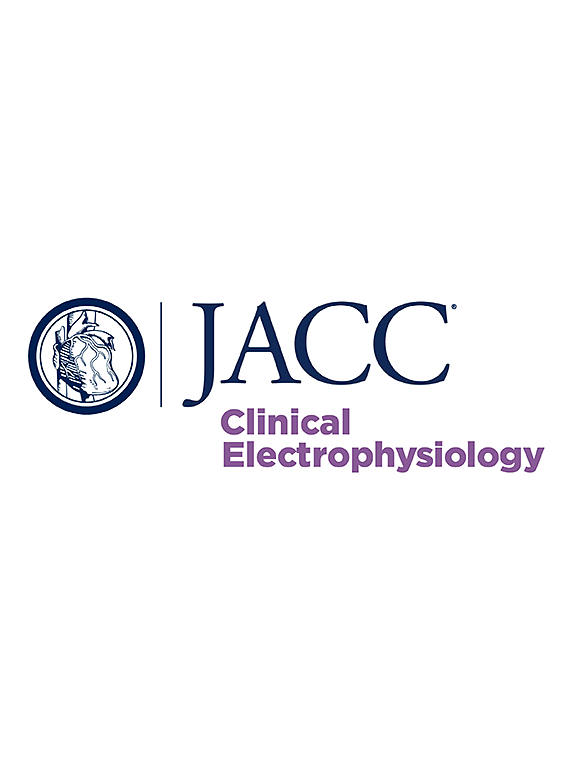Clinical Response to Resynchronization Therapy
IF 7.7
1区 医学
Q1 CARDIAC & CARDIOVASCULAR SYSTEMS
引用次数: 0
Abstract
Background
Randomized studies comparing conduction system pacing (CSP) with biventricular pacing (BiVP) are scarce and do not include clinical outcomes.
Objectives
The CONSYST-CRT (Conduction System Pacing vs Biventricular Resynchronization Therapy in Systolic Dysfunction and Wide QRS) trial aimed to test the noninferiority of CSP as compared with BiVP in patients with an indication for cardiac resynchronization therapy, with respect to a combined clinical endpoint at 1-year follow-up.
Methods
A total of 134 patients with cardiac resynchronization therapy indication were randomized to BiVP or CSP and followed up for 12 months. Crossover was allowed when the primary allocation procedure failed. The atrioventricular interval was optimized to obtain fusion with intrinsic conduction. The primary combined endpoint was all-cause mortality, cardiac transplant, heart failure hospitalization, or left ventricular ejection fraction (LVEF) improvement <5 points at 12 months. Secondary endpoints were LVEF increase, LV end-systolic volume (LVESV) decrease, echocardiographic response (≥15% LVESV decrease), QRS shortening, septal flash correction, NYHA functional class improvement, and a combined endpoint of all-cause mortality, cardiac transplantation, and heart failure hospitalization.
Results
Sixty-seven patients were allocated to each group. Eighteen patients (26.9%) crossed from CSP to BiVP; 5 (7.5%) crossed over from BiVP to CSP. Noninferiority (NI) was observed for CSP compared with BiVP for the primary endpoint (23.9% vs 29.8%, respectively; mean difference −5.9; 95% CI: −21.1 to 9.2; P = 0.02) and for the combined endpoint of all-cause mortality, cardiac transplantation, and heart failure hospitalization (11.9% vs 17.9%; P < 0.01 NI); echocardiographic response (66.6% vs 59.7%; P = 0.03 NI); NYHA functional class (P < 0.001 NI); and QRS shortening (P < 0.01). LVEF, LVESV, and septal flash endpoint values were similar, but noninferiority was not met (14.1% ± 10% vs 14.4% ± 10%, −27.9% ± 27% vs −27.9% ± 28%, −2.2 ± 2.7 mm vs −2.7 ± 2.4 mm, respectively).
Conclusions
CSP was noninferior to BiVP in achieving clinical and echocardiographic response, suggesting that CSP could be an alternative to BiVP. (Conduction System Pacing vs Biventricular Resynchronization Therapy in Systolic Dysfunction and Wide QRS [CONSYST-CRT]; NCT05187611)
再同步化治疗的临床反应:传导系统起搏vs双心室起搏。CONSYST-CRT审判。
背景:比较传导系统起搏(CSP)和双心室起搏(BiVP)的随机研究很少,而且不包括临床结果。目的:consystt - crt(传导系统起搏与收缩功能障碍双心室再同步化治疗和宽QRS)试验旨在测试CSP与BiVP在心脏再同步化治疗指征患者中的非劣效性,涉及1年随访的联合临床终点。方法:consys - crt是一项随机、对照、非劣效性试验(NCT05187611)。134例心脏再同步化治疗指征患者随机分为BiVP组或CSP组,随访12个月。当主分配过程失败时,允许交叉。优化房室间期以获得与内禀传导的融合。主要联合终点为全因死亡率、心脏移植、心力衰竭住院或左室射血分数(LVEF)改善。结果:每组67例患者。18例(26.9%)患者从CSP转为BiVP;5株(7.5%)从BiVP转化为CSP。与BiVP相比,CSP在主要终点的非劣效性(NI)分别为23.9%和29.8%;平均差-5.9;95% CI: -21.1 ~ 9.2;P = 0.02)以及全因死亡率、心脏移植和心力衰竭住院治疗的联合终点(11.9% vs 17.9%;P < 0.01 ni);超声心动图反应(66.6% vs 59.7%;P = 0.03 ni);NYHA功能分类(P < 0.001 NI);QRS缩短(P < 0.01)。LVEF、LVESV和间隔闪光终点值相似,但未达到非效性(分别为14.1±10% vs 14.4±10%,-27.9±27% vs -27.9±28%,-2.2±2.7 mm vs -2.7±2.4 mm)。结论:CSP在获得临床和超声心动图反应方面不逊于BiVP,表明CSP可以替代BiVP。传导系统起搏与双心室再同步治疗在收缩功能障碍和宽QRS中的应用[consysts - crt];NCT05187611)。
本文章由计算机程序翻译,如有差异,请以英文原文为准。
求助全文
约1分钟内获得全文
求助全文
来源期刊

JACC. Clinical electrophysiology
CARDIAC & CARDIOVASCULAR SYSTEMS-
CiteScore
10.30
自引率
5.70%
发文量
250
期刊介绍:
JACC: Clinical Electrophysiology is one of a family of specialist journals launched by the renowned Journal of the American College of Cardiology (JACC). It encompasses all aspects of the epidemiology, pathogenesis, diagnosis and treatment of cardiac arrhythmias. Submissions of original research and state-of-the-art reviews from cardiology, cardiovascular surgery, neurology, outcomes research, and related fields are encouraged. Experimental and preclinical work that directly relates to diagnostic or therapeutic interventions are also encouraged. In general, case reports will not be considered for publication.
 求助内容:
求助内容: 应助结果提醒方式:
应助结果提醒方式:


